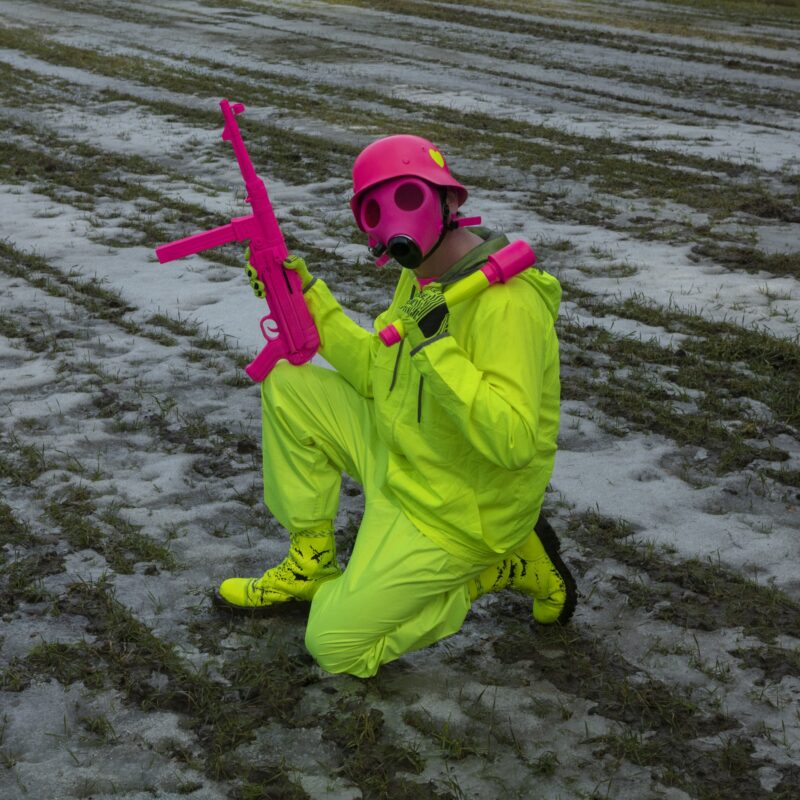The Gravity of the Situation
Curator: Agnieszka Rayss
Artists: Czarne Szmaty, Dominika Gęsicka, Maurycy Gomulicki, Zbigniew Libera, Łódź Kaliska, Orange Alternative, PAT MIC, Weronika Perłowska, Krzysztof Powieża, Agnieszka Sejud, MIchał Sita, Paweł Starzec, Tytus Szabelski, Karolina, Wojtas.
Can the artist joke in times of tension and crisis? Can irony and lampoon be effective tools of protest? At first glance, these do not seem to meet the seriousness of rebellion and resistance—but in times of crisis, we are not always entirely serious. Sometimes the formula of mass demonstrations turns out to be insufficient, and it is through the absurd and the burlesqued that the monopoly on truth is broken.
The exhibition The Gravity of the Situation presents the effects of actions by artists who transform social reality into art, often deflating pathos and monumental narratives. They also take a stand on important social and political issues—issues of identity and prevailing historical narratives, or concerning human rights. Many of the works presented in the exhibition were created with the participation of ‘ordinary people.’ Sometimes it is the ‘ordinary people’ and their actions that trigger fresh associations and reactions, as observed during numerous protests.
The artists disarm the strategies and prescribed norms regulating the functioning of the system and reveal the ridiculousness of a repressive facade. Any police officer can become a work of art—it is enough to engage with them in an action, whether they want to or not.1 Resistance can become a happening. Both share in common skepticism and a sense of humour in the face of an ossified system. In this way, the satirically absurd can undermine power and disrupt fixed patterns.
The communist-era street actions of the Orange Alternative (Pomarańczowa Alternatywa) were absurdist weapons wielded against the oppression of the authorities. The police were helpless in response. There was a carnival festivity in the streets and the crime was unprovable because the accusation self-ridiculed the authorities. The system itself was a work of art. You didn’t have to come up with anything. You just had to look at it.
What are the responsibilities of the artist in difficult times (which is to say, to varying degrees, always)? To observe, to comment on, to play in the shadows of growing conflict? Can they mock the martyrological tradition and pick apart national myths on all sides? Is the figure of the ironic observer permitted? Is there any point to this sort of apocalyptic hedonism?
With their practice, an artist, and especially a photographer, can bear witness, spur action, and seek to change the world. However, it is precisely this world, observed at close range, that can be so fascinatingly outrageous that it is difficult to pass by with indifference. The artistic carnival continues, its works finding their places in galleries and publications, on social media and on the streets. Artists commandeer images from visual culture and invert their meaning, sometimes creating the appearance of identifying themselves with the opposing view. In fact, one might ask: If there is still so much space for mirth, then why protest? Why must we fight when there’s so much fun to be had?
It is safe to assume that a joke, including the most morbidly ironic, will someday come to pass in reality—and no doubt it is this the system fears. Witty slogans on cardboard signs and in memes will cease to be utopia, and the revolution will shift from streets and galleries to daily life. After all, the collapse of any system of power can be a tragicomedy.
Agnieszka Rayss is a photographer, lecturer, and curator. She is a co-founder of the Sputnik Photos collective. She graduated in art history from the Jagiellonian University in Krakow, and now lectures at the School of Form at SWPS University in Warsaw. She is interested in topics related to myths, history and its reinterpretation, and the post-Soviet heritage of Central and Eastern Europe. Her early works were devoted to pop culture manifestations of transformation. She is the author of the photography albums From the Notes of a Collector (2019); This Is Where the End of Cities Begins (2015), about the disturbing industrial side of urban ‘organisms’; and American Dream (2010), about the cultural transformations and triumph of pop culture in post-Soviet Central and Eastern Europe.
PLACE:
CRICOTEKA, ul. Nadwiślańska 2–4
EXHIBITION CLOSED
TICKETS:
10 zł N / 5 zł U



